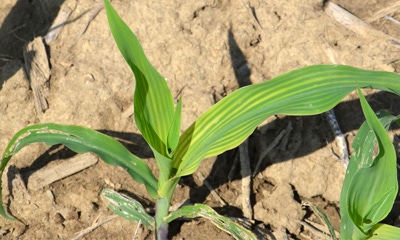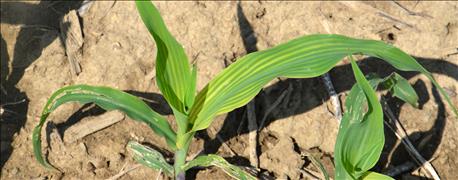
If you find a corn plant here and there showing stripes on its leaves, that’s one thing. If an entire field is showing symptoms, that’s something else. Andy Westhoven, an AgriGold agronomist, says if that’s the case, you will want to investigate and find the cause. More than likely it’s related to a nutrient deficiency.
Corn Illustrated 6/6: What you can expect from late-planted corn
You can find photos of plants with various patterns of leaf striping in the Purdue University Corn & Soybean Field Guide. The guide is prepared by Purdue’s Crop Diagnostic Training and Research Center, headed by Corey Gerber.
Here are four possible causes of striping.

DIAGNOSE CAUSE OF STRIPING: If it’s just a single plant here and there, it may not be a big issue. If large areas have striped plants, consider investigating the cause.
1. Striping may be related to hybrid genetics.
Some hybrids tend to show striping on leaves, especially earlier in the season. Agronomists have shown that this simple striping does not affect yields. It may just be a trait within the genetics of that particular hybrid.
2. Striping could be a sign of sulfur deficiency.
If striping is due to a lack of sulfur, Westhoven says there may be an overall yellowing, similar to that which develops if nitrogen is deficient. He notes that sulfur is not mobile in the plant, however. So look for symptoms on newer leaves at the top of the plant first.
Sulfur deficiency often shows up first on sandier soils. Agronomists in areas where soils are irrigated often watch closely for these symptoms. Until the last couple of decades, sulfur was typically not an issue. After power plants added equipment to clean up coal emissions, sulfur available to corn has decreased.
3. Look for symptoms of zinc deficiency.
White or yellowish-white stripes on leaves may indicate zinc deficiency, Westhoven notes. The midrib and outside margins may remain green. Look for symptoms on newer leaves first, he says. Corn may be stunted.
The Purdue guide says low zinc levels in the soil combined with high pH and/or high phosphorus levels in the soil may lead to these symptoms. Cool, wet soils, cloudy conditions and soil compaction are other factors that may cause plants to become deficient in zinc.
4. These symptoms might indicate manganese deficiency.
Westhoven says olive green or mustard yellow plants with white stripes could indicate manganese deficiency. Again, symptoms will likely appear on newer leaves first. The Purdue guide notes you are most likely to see this in depressed areas in a field, or in sands, peats or mucks.
Corn Ilustrated 5/30: 4 major corn leaf diseases to watch for in 2016
If you suspect any of these deficiencies, Westhoven suggests taking up to 15 to 20 leaf samples and sending them in for tissue analysis. He stresses, however, that it’s critical to pull leaves from both affected areas and areas where corn appears normal. Send both samples to the lab.
About the Author(s)
You May Also Like




